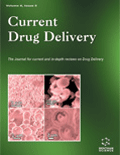To find the most relevant journal, please insert appropriate keyword to facilitate search.
Search Results: CDD

Current Drug Delivery
ISSN: 1567-2018 (Print)
eISSN: 1875-5704 (Online)
The journal aims to cover the latest outstanding developments in drug and vaccine delivery employing physical, physico-chemical and chemical methods. The drugs include a wide range of bioactive compounds from simple pharmaceuticals to peptides, proteins, nucleotides, nucleosides and sugars. The journal will also report progress in the fields of transport routes and mechanisms including efflux proteins and multi-drug resistance.
The journal is essential for all pharmaceutical scientists involved in drug design, development and delivery.
Special Issues With Active Call for Papers
Potential of Electrospinning for Current Drug Delivery
Electrospinning is versatile polymer processing technology used for fabrication of nanofibers. Nanofibers explored for drug delivery, tissue engineering, and biomedical applications. It has unique properties of high surface area, porosity, stability, and excellent morphology. This electrospinning technology gained significant attention in recent years for due to its ability to overcomes limitations of traditional drug delivery methods. The proposed thematic issue aims to explore the potential of electrospinning technology in revolutionizing drug delivery, tissue engineering and... see more
Advancements in Robotic and AI-based Drug Discovery and Delivery for Neurological Disorders
Neurological disorders, including Alzheimer's disease, Parkinson's disease, epilepsy, and brain tumors, pose significant challenges in drug delivery due to the blood-brain barrier's intricate structure and the complexity of neuronal networks. Traditional drug delivery methods often fall short in reaching therapeutic concentrations within the central nervous system, limiting treatment efficacy and patient outcomes. This proposed special issue aims to address these challenges by showcasing the latest advancements in Robotic and AI-based drug discovery and delivery systems... see more
Pioneering Drug Delivery Strategies for Enhanced Cancer Immunotherapies
The landscape of cancer treatment has been fundamentally transformed by the advent of immunotherapy, a modality that harnesses the body's immune system to recognize and combat malignant cells. Despite its remarkable successes, the full potential of cancer immunotherapy is yet to be realized, largely due to limitations in targeted delivery, systemic toxicity, and tumor microenvironment-induced resistance. This special issue, "Pioneering Drug Delivery Strategies for Enhanced Cancer Immunotherapies," aims to showcase the latest advancements and innovative... see more
Tumor-targeted drug delivery systems
Tumor-targeted drug delivery systems present immense potential to revolutionize cancer treatment paradigms. This field, characterized by its intricate blend of material engineering, chemistry, biology, pharmacy, and pathology, constitutes a complex domain at the intersection of science and medicine. Thus, it is crucial to recognize the interdisciplinary structure of this field and promote communication among experts in various related fields from academia, clinics, and industry. The main goal of this section is to provide a comprehensive... see more
Electrospun Fibers as Drug Delivery Systems
In recent years, electrospun fibers have attracted considerable attention as potential platforms for drug delivery due to their distinctive properties and adaptability. These fibers feature a notable surface area-to-volume ratio and can be intentionally designed with high porosity, facilitating an increased capacity for drug loading and rendering them suitable for delivering both hydrophilic and hydrophobic drugs. The morphology of electrospun fibers can be customized to precisely control the release kinetics of drugs, with adjustments in... see more
Nanotechnology Based Chemotherapy for the treatment of Head & Neck Cancer
The escalating recurrence rates observed in Head and Neck cancer, particularly within the chemo-therapeutically treated cohort (50-60%), can be attributed to the non-selective nature of current anticancer drug delivery modalities. In this context, nanotechnology-based drug delivery systems emerge as a promising avenue for achieving precise localization of therapeutic agents to neoplastic sites via interaction with cell surface primer sites. The integration of nanotechnology in drug delivery holds potential for optimizing the pharmacokinetics, therapeutic efficacy, and... see more
Advances of natural products, bio-actives and novel drug delivery system against emerging viral infections
Due to the increasing prevalence of viral infections and the ability of these human pathogens to develop resistance to current treatment strategies, there is a great need to find and develop new compounds to combat them. These molecules must have low toxicity, specific activity and high bioavailability. The most suitable compounds for this task are usually derived from natural sources. Therefore, natural products are considered one of the most positive and practical approaches to defeat... see more
Emerging Nanotherapeutics for Mitigation of Neurodegenerative Disorders
Conditions affecting the central nervous system (CNS) present a significant hurdle due to limited access of both treatments and diagnostic tools for the brain. The blood-brain barrier (BBB) acts as a barrier, restricting the passage of molecules from the bloodstream into the brain. The most formidable challenge facing scientists is comprehending and treating the mechanisms underlying neurodegenerative disorders, with a growing concern for neurodegenerative disorders, particularly in the cases of Parkinson’s, Alzheimer’s, ALS, and others,... see more